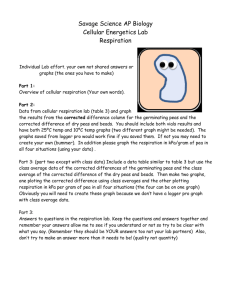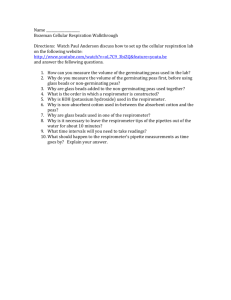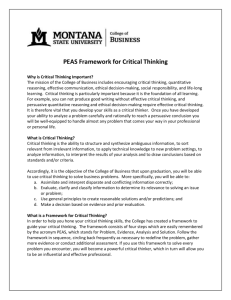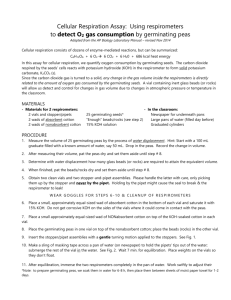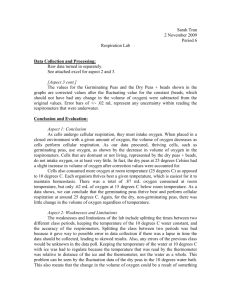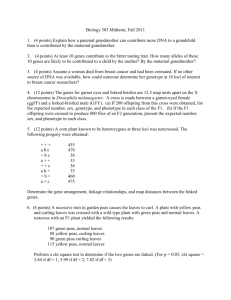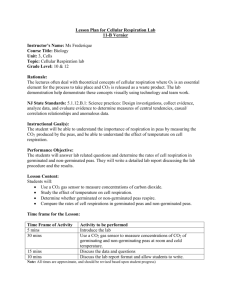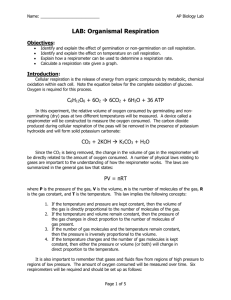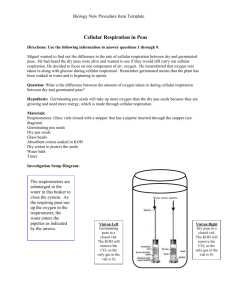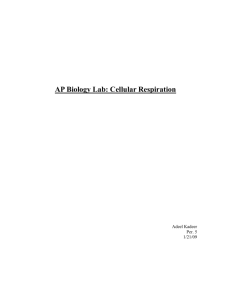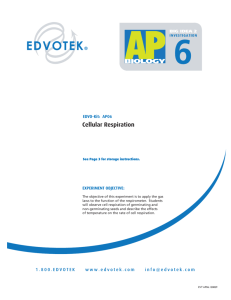Understanding Respiration
advertisement
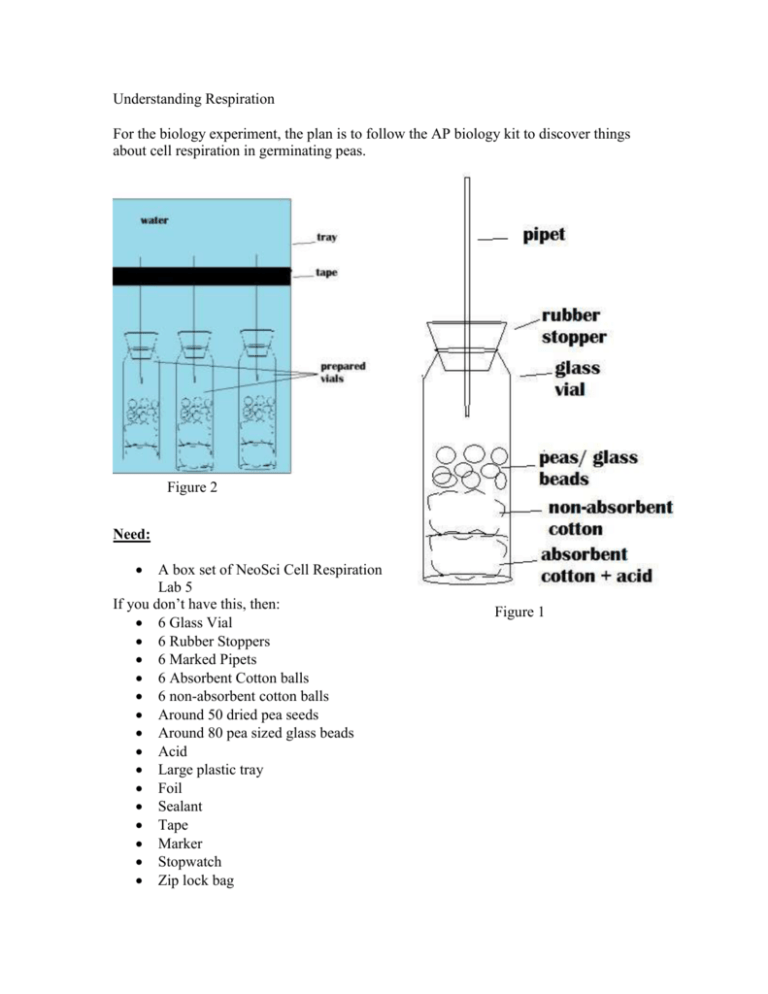
Understanding Respiration For the biology experiment, the plan is to follow the AP biology kit to discover things about cell respiration in germinating peas. Figure 2 Need: A box set of NeoSci Cell Respiration Lab 5 If you don’t have this, then: 6 Glass Vial 6 Rubber Stoppers 6 Marked Pipets 6 Absorbent Cotton balls 6 non-absorbent cotton balls Around 50 dried pea seeds Around 80 pea sized glass beads Acid Large plastic tray Foil Sealant Tape Marker Stopwatch Zip lock bag Figure 1 Graduated cylinder Paper towels Water heater Procedure: Germinating Peas: 1. Take a little more than half of the peas (~30) and place them in a shallow tray. 2. Fill the tray with water so that it just covers them 3. After a day, take around 3 paper towels, soak them, squeeze out excess water, and place the peas inside. 4. Place the paper towels and the peas inside a zip lock bag 5. After a day or two, take out the peas. 6. Throw away any peas that are soft and use the ones that have a stem growing out. Setting up: 1. Fill a graduated cylinder up to 50 ml 2. Place half of the germinated peas in the cylinder, then subtract 50 ml from the total. This is the volume of the peas. 3. Drain the peas and place them on a paper towel marked 1a. 4. Fill another cylinder up to 50 ml 5. Take the same amount of dried pea seeds as the germinated peas, and place them in the cylinder. 6. Drop as many glass beads as it takes to make the volume exactly the same as the germinated peas. 7. Drain the pea seeds and the beads, and place them on paper towel marked 2a 8. Fill a cylinder up to 50 ml 9. Put as many glass beads as it takes to make the volume exactly the same as the previous volumes. 10. Drain and put on towel marked 3a 11. Repeat steps 1-10, but mark the towels 1b, 2b, and 3b 12. Place one absorbent cotton in each of the vials, and push it to the end 13. Drop a few drops of the acid in to the vials, avoiding the sides. Make sure each vial gets the same number of drops. 14. Place in a non-absorbent cotton and push this to the end. 15. Put the germinated peas in one vial, and mark the vial 1a. Do the same for the others. 16. Make the vials airtight by stopping it with a rubber stopper. 17. Enter the pipet narrow side first into the hole of the rubber stopper and seal with sealant so no water can go in. Experiment: 1. Fill the tray with water 2. Tape the width about 1/3 of the way. 3. Place each vial in the water, making sure the open end of the pipet stays above the water. 4. Use the stopwatch and leave for 7 minutes. 5. Completely immerse the glass vial in the water, and wait for 3 minutes. 6. After 3 minutes is up, take down the measurement on the marked pipet for each of the vials 7. After that, take down measurements every 5 minutes until 20 minutes has passed since the first measurement. 8. Turn on the water heater, set it to a temperature, and wait until it has stabilized. 9. Place the B set of vials, holding it up for 7 minutes. 10. Immerse the vials for 3 minutes after, and then take down measurements. 11. Take down measurements every 5 minutes unti 20 minutes have passed since the first measurement. To figure out the correct measurements: First, you need to find the Room Temperature Correction Factor To do this, use the measurements from the beads only vial. Take the reading volume of a measurement that is not the first, and subtract the volume taken for the first one. Eg. Time Reading, ml Reading - Time 0 = Correction Factor 0 0.15 N/A 5 0.16 10 0.17 15 0.18 20 0.20 0.01 0.02 0.03 0.05 Then for the germinating pea seeds and the dry pea seeds measurements, we use the correction factor for that time and take that away from the volume that has been taken down. Eg. Time Reading, ml Volume ml: Reading - Time 0 Corrected Volume: Volume - Correction Factor 0 0.15 N/A 5 0.2 0.05 10 0.33 0.18 15 0.38 0.25 20 0.46 0.31 N/A 0.04 0.16 0.22 0.26 The last row for both tables would be your correct measurements. My data: Where 2 is beads only, 1 is germinating peas, and 2 is dry pea seeds and glass beads Where a is room temperature, and b is at 40 degrees C 3a 5 min 10 min 15 min 20 min 1a 2a 0.01 0 0.02 0.01 0.11 0.02 0.01 0.16 0.02 0.01 0.24 0.02 5 min 10 min 15 min 20 min 3b 1b 2b 0.05 0.08 0.1 0.25 0.55 0.4 0.4 0.78 0.65 0.5 0.97 0.8 From this data, a question had been answered that could not be answered before: does temperature change the rate of respiration? And the answer is yes, it does. When the temperature is higher, it seems like the germinated peas respire faster. Could the peas respire slower when it’s cooler? Through this experiment, I learnt many things, including how to germinate peas and using the water heater. I also learnt about cell respiration, what happens, and the temperature differences. What I would like to know more about is what the acid does. I also want to know the difference between having a pea sprout a root and having peas that haven’t sprouted, and the different respiration rate.
